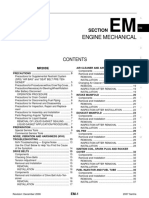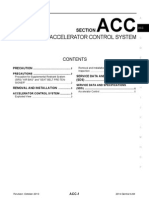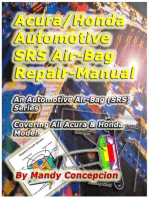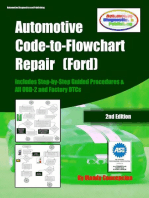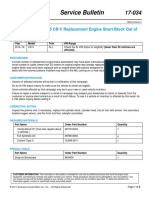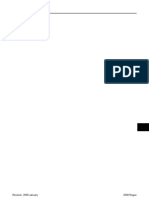0 ratings0% found this document useful (0 votes)
100 viewsSupplemental Restraint System (SRS) : Section
Supplemental Restraint System (SRS) : Section
Uploaded by
Oscar GonzálezThis document provides information about troubleshooting a supplemental restraint system (SRS) including air bags and seat belt pre-tensioners. It discusses safety precautions for working on the SRS and describes the diagnostic procedures and special service tools. The SRS configuration is shown and wiring diagrams are provided. The document gives instructions for replacing components like the driver air bag module and spiral cable. Procedures for deploying air bags and pre-tensioners outside and inside the vehicle are also described.
Copyright:
© All Rights Reserved
Available Formats
Download as PDF, TXT or read online from Scribd
Supplemental Restraint System (SRS) : Section
Supplemental Restraint System (SRS) : Section
Uploaded by
Oscar González0 ratings0% found this document useful (0 votes)
100 views36 pagesThis document provides information about troubleshooting a supplemental restraint system (SRS) including air bags and seat belt pre-tensioners. It discusses safety precautions for working on the SRS and describes the diagnostic procedures and special service tools. The SRS configuration is shown and wiring diagrams are provided. The document gives instructions for replacing components like the driver air bag module and spiral cable. Procedures for deploying air bags and pre-tensioners outside and inside the vehicle are also described.
Original Title
Srs
Copyright
© © All Rights Reserved
Available Formats
PDF, TXT or read online from Scribd
Share this document
Did you find this document useful?
Is this content inappropriate?
This document provides information about troubleshooting a supplemental restraint system (SRS) including air bags and seat belt pre-tensioners. It discusses safety precautions for working on the SRS and describes the diagnostic procedures and special service tools. The SRS configuration is shown and wiring diagrams are provided. The document gives instructions for replacing components like the driver air bag module and spiral cable. Procedures for deploying air bags and pre-tensioners outside and inside the vehicle are also described.
Copyright:
© All Rights Reserved
Available Formats
Download as PDF, TXT or read online from Scribd
Download as pdf or txt
0 ratings0% found this document useful (0 votes)
100 views36 pagesSupplemental Restraint System (SRS) : Section
Supplemental Restraint System (SRS) : Section
Uploaded by
Oscar GonzálezThis document provides information about troubleshooting a supplemental restraint system (SRS) including air bags and seat belt pre-tensioners. It discusses safety precautions for working on the SRS and describes the diagnostic procedures and special service tools. The SRS configuration is shown and wiring diagrams are provided. The document gives instructions for replacing components like the driver air bag module and spiral cable. Procedures for deploying air bags and pre-tensioners outside and inside the vehicle are also described.
Copyright:
© All Rights Reserved
Available Formats
Download as PDF, TXT or read online from Scribd
Download as pdf or txt
You are on page 1of 36
SRS-1
SUPPLEMENTAL RESTRAINT SYSTEM(SRS)
H RESTRAINTS
CONTENTS
C
D
E
F
G
I
J
K
L
M
SECTION
A
B
SRS
SUPPLEMENTAL RESTRAINT SYSTEM (SRS)
PRECAUTIONS .......................................................... 3
Supplemental Restraint System (SRS) AIR BAG
and SEAT BELT PRE-TENSIONER ...................... 3
Precautions for SRS AIR BAG and SEAT BELT
PRE-TENSIONER Service ..................................... 3
Trouble Diagnosis Precaution .................................. 3
PREPARATION ...................................................... ..... 4
Special Service Tool ............................................ ..... 4
Commercial Service Tool ......................................... 4
SUPPLEMENTAL RESTRAINT SYSTEM (SRS) ....... 5
SRS Configuration .............................................. ..... 5
TROUBLE DIAGNOSIS ......................................... ..... 6
Trouble Diagnoses-Introduction ............................... 6
DIAGNOSIS FUNCTION .................................. ..... 6
HOW TO PERFORM TROUBLE DIAGNOSES
FOR QUICK AND ACCURATE REPAIR ............... 6
WORK FLOW ................................................... ..... 7
SRS Components Parts Location ............................. 8
Wiring Diagram-SRS-/RHD models .................... ..... 9
Wiring Diagram-SRS-/LHD models ........................ 10
CONSULT-II Function ......................................... ....11
DIAGNOSIS MODE FOR CONSULT-II ................11
HOW TO CHANGE SELF-DIAGNOSIS MODE
WITH CONSULT-II ...............................................11
HOWTOERASE SELF-DIAGNOSISRESULTS....11
Self-Diagnosis Function (Without CONSULT-II) .. ... 12
HOW TO CHANGE SELF-DIAGNOSIS MODE... 12
HOWTOERASE SELF-DIAGNOSISRESULTS... 12
SRS Operation Check ......................................... ... 12
DIAGNOSTIC PROCEDURE 1 ........................... 12
Trouble Diagnoses with CONSULTII .................... 15
DIAGNOSTIC PROCEDURE 2 ........................... 15
DIAGNOSTIC PROCEDURE 3 ........................... 17
DIAGNOSTIC PROCEDURE 4 ........................... 17
Trouble Diagnoses without CONSULT-II. ............... 19
DIAGNOSTIC PROCEDURE 5 ........................... 19
WARNING LAMP FLASH CODE CHART ........... 19
TroubleDiagnoses:AIRBAGWarningLampDoes
Not Turn Off ............................................................ 20
DIAGNOSTIC PROCEDURE 6 ........................ ... 20
TroubleDiagnoses: AIRBAG WarningLampDoes
Not Turn On ......................................................... ... 21
DIAGNOSTIC PROCEDURE 7 ........................ ... 21
DRIVER AIR BAG MODULE .................................... 22
Removal and Installation ..................................... ... 22
REMOVAL ........................................................ ... 22
INSTALLATION ................................................ ... 23
SPIRAL CABLE ........................................................ 25
Removal and Installation ..................................... ... 25
REMOVAL ........................................................ ... 25
INSTALLATION ................................................ ... 26
Components Inspection ....................................... ... 26
FRONT SEAT BELT PRE-TENSIONER ................... 27
Removal and Installation ..................................... ... 27
DIAGNOSIS SENSOR UNIT .................................. ... 28
Removal and Installation ..................................... ... 28
REMOVAL ........................................................ ... 28
INSTALLATION ................................................ ... 28
ECU DISCRIMINATED NO. ............................. ... 28
DISPOSALOFAIRBAGMODULEANDSEATBELT
PRE-TENSIONER .................................................. ... 29
Caution for Air Bag Module and Seat Belt Pre-ten-
sioner ................................................................... ... 29
CHECKING DEPLOYMENT TOOL ..................... 29
DEPLOYMENT PROCEDURES FOR AIR BAG
MODULE (OUTSIDE OF VEHICLE) ................... 30
DEPLOYMENT PROCEDURES FOR SEAT
BELT PRE-TENSIONER (OUTSIDE OF VEHI-
CLE)(RHD MODELS) .......................................... 31
DEPLOYMENT PROCEDURES FOR SEAT
BELT PRE-TENSIONER (OUTSIDE OF VEHI-
CLE)(LHD MODELS) .......................................... 31
DEPLOYMENT OF AIR BAG MODULE AND
SEAT BELT PRE-TENSIONER WHILE
MOUNTED IN VEHICLE(RHD MODELS) ........ ... 32
DEPLOYMENT OF AIR BAG MODULE AND
SEAT BELT PRE-TENSIONER WHILE
MOUNTED IN VEHICLE(LHD MODELS) ............ 32
DISPOSINGOF AIRBAGMODULEAND SEAT
SRS-2
BELT PRE-TENSIONER .................................. ... 33
COLLISION DIAGNOSIS .......................................... 34
For Frontal Collision ................................................ 34
SRS INSPECTION (FOR FRONTAL COLLI-
SION) ................................................................ ...34
PRECAUTIONS
SRS-3
C
D
E
F
G
I
J
K
L
M
A
B
SRS
PRECAUTIONS PFP:00001
Supplemental Restraint System (SRS) AIR BAG and SEAT BELT PRE-TEN-
SIONER EHS000BM
The Supplemental Restraint System such as AIR BAG and SEAT BELT PRE-TENSIONER used along with
a front seat belt, helps to reduce the risk or severity of injury to the driver and front passenger for certain types
of collision.
WARNING:
G To avoid rendering the SRS inoperative, which could increase the risk of personal injury or death
in the event of a collision which would result in air bag inflation, all maintenance should be per-
formed by an authorized NISSAN/INFINITI dealer.
G Improper maintenance, including incorrect removal and installation of the SRS, can lead to per-
sonal injury caused by unintentional activation of the system.
G Do not use electrical test equipment on any circuit related to the SRS unless instructed to in this
Service Manual. SRS wiring harnesses can be identified by yellow harness connector.
Precautions for SRS AIR BAG and SEAT BELT PRE-TENSIONER Service
EHS000BN
G Do not use electrical test equipment to check SRS circuits unless instructed to in this Service Manual.
G Before servicing the SRS, turn ignition switch OFF, disconnect battery ground cable and wait at least 3
minutes.
For approximately 3 minutes after the cables is removed, it is still possible for the air bag and seat belt
pre-tensioner to deploy. Therefore, do not work on any SRS connectors or wires until at least 3 minutes
have passed.
G Diagnosis sensor unit must always be installed with their arrow marks pointing towards the front of the
vehicle for proper operation. Also check diagnosis sensor unit for cracks, deformities or rust before instal-
lation and replace as required.
G The spiral cable must be aligned with the neutral position since its rotations are limited. Do not attempt to
turn steering wheel or column after removal of steering gear.
G Handle air bag module carefully. Always place driver air bag modules with the pad side facing upward.
G Conduct self-diagnosis to check entire SRS for proper function after replacing any components.
G After air bag inflates, the front instrument panel assembly should be replaced if damaged.
Trouble Diagnosis Precaution EHS000BO
When you read wiring diagrams, refer to the followings:
G HOW TO READ WIRING DIAGRAMS in GI section
G PG-2, "POWER SUPPLY ROUTING" in PG section
When you perform trouble diagnosis, refer to the followings:
G HOW TO FOLLOW TEST GROUP IN TROUBLE DIAGNOSIS in GI section
G HOW TO PERFORM EFFICIENT DIAGNOSIS FOR AN ELECTRICAL INCIDENT in GI section
Check for any service bulletins before servicing the vehicle.
SRS-4
PREPARATION
PREPARATION PFP:00002
Special Service Tool EHS000BP
Commercial Service Tool EHS000BQ
Tool number
Tool name
Application
KV99105300
Air bag module bracket
Anchoring air bag module
KV99106400
Deployment tool
Disposing of air bag module and front seat
belt pre-tensioner
KV99109700
Deployment tool adapter for driver
air bag module
Connection between the deployment tool
and driver air bag module
KV99108300
Deployment tool adapter for front
passenger air bag
Connection between the deployment tool
and front passenger air bag module
KV99107900
Deployment tool adapter for front
seat belt pre-tensioner
(RHD models)
Connection between the deployment tool
and front seat belt pre-tensioner
S-NT354
S-NT357
SHIA0038J
ZZA1166D
SHIA0234J
Tool name Application
Tamper resistant torx socket Size:T30
S-NT757
SUPPLEMENTAL RESTRAINT SYSTEM (SRS)
SRS-5
C
D
E
F
G
I
J
K
L
M
A
B
SRS
SUPPLEMENTAL RESTRAINT SYSTEM (SRS) PFP:28556
SRS Configuration EHS000BR
SHIA0245E
SRS-6
TROUBLE DIAGNOSIS
TROUBLE DIAGNOSIS PFP:00004
Trouble Diagnoses-Introduction EHS000BV
CAUTION:
G Do not use electrical test equipment on any circuit related to the SRS unless instructed to in this
Service Manual. SRS wiring harness can be identified by yellow harness connector.
G Do not attempt to repair, splice or modify the SRS wiring harness. If the harness is damaged,
replace it with a new one.
G Keep ground portion clean.
DIAGNOSIS FUNCTION
The SRS self-diagnosis results can be read by using AIR BAG warning lamp and/or CONSULT-II.
The User mode is exclusively prepared for the customer (driver). This mode warns the driver of a system mal-
function through the operation of the AIR BAG warning lamp.
The Diagnosis mode allows the technician to locate and inspect the malfunctioning part.
The mode applications for the AIR BAG warning lamp and CONSULT-II are as follows:
NOTE:
Seat belt pre-tensioner malfunction is indicated by AIR BAG warning lamp.
HOW TO PERFORM TROUBLE DIAGNOSES FOR QUICK AND ACCURATE REPAIR
A good understanding of the malfunction conditions can make troubleshooting faster and more accurate.
In general, each customer feels differently about a malfunction. It is important to fully understand the symp-
toms or conditions for a customer complaint.
Information from Customer
WHAT..... Vehicle model
WHEN..... Date, Frequencies
WHERE..... Road conditions
HOW..... Operating conditions, Symptoms
Preliminary Check
Check that the following parts are in good order.
G Battery, refer to PG-2, "POWER SUPPLY ROUTING" .
G Fuse, refer to PG-78, "Terminal Arrangement" .
G System component-to-harness connections
User mode Diagnosis mode Display type
AIR BAG warning lamp X X ON-OFF operation
CONSULT-II X Monitoring
TROUBLE DIAGNOSIS
SRS-7
C
D
E
F
G
I
J
K
L
M
A
B
SRS
WORK FLOW
NOTE:
Seat belt pre-tensioner malfunction is indicated by AIR BAG warning lamp.
*1: SRS-6 *2: SRS-12 *3: SRS-17
*4: SRS-19
SHIA0175E
SRS-8
TROUBLE DIAGNOSIS
SRS Components Parts Location EHS000BW
PHIA0016E
TROUBLE DIAGNOSIS
SRS-9
C
D
E
F
G
I
J
K
L
M
A
B
SRS
Wiring Diagram-SRS-/RHD models EHS000BZ
THWH0001E
SRS-10
TROUBLE DIAGNOSIS
Wiring Diagram-SRS-/LHD models EHS000DK
THWH0002E
TROUBLE DIAGNOSIS
SRS-11
C
D
E
F
G
I
J
K
L
M
A
B
SRS
CONSULT-II Function EHS000C0
DIAGNOSIS MODE FOR CONSULT-II
G SELF-DIAG [CURRENT]
A current Self-diagnosis result (also indicated by the number of warning lamp flashes in the Diagnosis
mode) is displayed on the CONSULT-II screen in real time. This refers to a malfunctioning part requiring
repairs.
G SELF-DIAG [PAST]
Diagnosis results previously stored in the memory are displayed on the CONSULT-II screen. The stored
results are not erased until memory erasing is executed.
G TROUBLE DIAG RECORD
With TROUBLE DIAG RECORD, diagnosis results previously erased by a reset operation can be dis-
played on the CONSULT-II screen.
G ECU DISCRIMINATED NO.
The diagnosis sensor unit for each vehicle model is assigned with its own, individual classification num-
ber. This number will be displayed on the CONSULT-II screen, as shown below. When replacing the diag-
nosis sensor unit, refer to the part number for the compatibility. After installation, replacement with a
correct unit can be checked by confirming this classification number on the CONSULT-II screen.
HOW TO CHANGE SELF-DIAGNOSIS MODE WITH CONSULT-II
From User Mode to Diagnosis Mode
After selecting AIR BAG on the SELECT SYSTEM screen, User mode automatically changes to Diagnosis
mode.
From Diagnosis Mode to User Mode
To return to User mode from Diagnosis mode, touch BACK key of CONSULT-II until SELECT SYSTEM
appears, Diagnosis mode automatically changes to User mode.
HOW TO ERASE SELF-DIAGNOSIS RESULTS
G SELF-DIAG [CURRENT]
A current Self-diagnosis result is displayed on the CONSULT-II screen in real time.
After the malfunction is repaired completely, no malfunction is detected on SELF-DIAG [CURRENT].
G SELF-DIAG [PAST]
Return to the SELF-DIAG [CURRENT] CONSULT-II screen by touching BACK key of CONSULT-II and
select SELF-DIAG [CURRENT] in SELECT DIAG MODE. Touch ERASE in SELF-DIAG [CURRENT]
mode.
SRS803
SRS804
SRS-12
TROUBLE DIAGNOSIS
NOTE:
If the memory of the malfunction in SELF-DIAG [PAST] is not erased, the User mode shows the
system malfunction by the operation of the warning lamp even if the malfunction is repaired com-
pletely.
G TROUBLE DIAG RECORD
The memory of TROUBLE DIAG RECORD cannot be erased
Self-Diagnosis Function (Without CONSULT-II) EHS000C1
G The reading of these results is accomplished using one of two modes User mode and Diagnosis
mode.
G After a malfunction is repaired, turn the ignition switch OFF for at least one second, then back ON.
Diagnosis mode returns to the User mode. At that time, the self-diagnostic result is cleared.
HOW TO CHANGE SELF-DIAGNOSIS MODE
HOW TO ERASE SELF-DIAGNOSIS RESULTS
After a malfunction is repaired, turn the ignition switch OFF for at least one second, then back ON. Diagno-
sis mode returns to the User mode. At that time, the self-diagnostic result is cleared.
SRS Operation Check EHS000C2
DIAGNOSTIC PROCEDURE 1
Checking Air Bag Operation by Using AIR BAG Warning Lamp-User Mode
1. Turn the ignition switch from OFF to ON, and check that the air bag warning lamp blinks.
SRS701
SHIA0183E
TROUBLE DIAGNOSIS
SRS-13
C
D
E
F
G
I
J
K
L
M
A
B
SRS
2. Compare the SRS air bag warning lamp blinking pattern with the
examples.
BF-1845D
SRS-14
TROUBLE DIAGNOSIS
Warning lamp examples
AIR BAG warning lamp operation-User mode- SRS condition Reference item
G No malfunction is detected.
G No further action is necessary.
G The system is malfunctioning and
need to be repaired as indicated.
Go to SRS-17, "DIAGNOSTIC
PROCEDURE 4" .
G Air bag is deployed.
G Seat belt pre-tensioner is deployed.
Go to SRS-34, "COLLISION DIAG-
NOSIS" .
G Diagnosis sensor unit is malfunction-
ing.
G Air bag power supply circuit is mal-
functioning.
G SRS air bag warning lamp circuit is
malfunctioning.
Go to SRS-20, "Trouble Diagnoses:
AIR BAG Warning Lamp Does Not
Turn Off" .
G Diagnosis sensor unit is malfunction-
ing.
G Air bag warning lamp circuit is mal-
functioning.
Go to SRS-21, "Trouble Diagnoses:
AIR BAG Warning Lamp Does Not
Turn On" .
SHIA0011E
SHIA0012E
SHIA0013E
SHIA0014E
TROUBLE DIAGNOSIS
SRS-15
C
D
E
F
G
I
J
K
L
M
A
B
SRS
Trouble Diagnoses with CONSULTII EHS000C3
DIAGNOSTIC PROCEDURE 2
1. Turn ignition switch OFF.
2. Connect CONSULT-II to the data link connector.
3. Turn ignition switch ON.
4. Touch START.
5. Touch AIR BAG.
6. On the self-diagnosis mode selection screen of CONSULT-II,
select the desired self-diagnosis mode key.
PBIA0412E
SRS695
SRS771
SRS697
SRS-16
TROUBLE DIAGNOSIS
a. Touch SELF-DIAG [CURRENT].
G Diagnostic code is displayed on SELF-DIAG [CURRENT].
i. If the malfunction is displayed in the SRS Operation Check (Air bag warning lamp blinking) but no mal-
function is displayed in the SELF-DIAG [CURRENT], the following possibilities shall be checked.
G After the malfunction part is repaired, the diagnosis results in SELF-DIAG [PAST] has not been
erased.
G An intermittent malfunction has been stored in the past.
NOTE:
Intermittent malfunction is a malfunction that has occurred once in the past, but soon recovered. Refer to
SRS-17, "DIAGNOSTIC PROCEDURE 3" and SRS-17, "DIAGNOSTIC PROCEDURE 4" .
b. Touch SELF-DIAG [PAST].
G The diagnostic code is displayed until erasing the memory in
the SELF-DIAG [CURRENT].
c. Touch TROUBLE DIAG RECORD.
G The diagnosis results (malfunction parts stored in the diagno-
sis sensor unit) stored in the self-diagnosis results are dis-
played.
G The memory of TROUBLE DIAG RECORD cannot be
erased.
7. Each diagnostic code is displayed.
8. Touch PRINT, if required.
9. Based on each diagnosis result, repair or replace the malfunc-
tion parts.
CAUTION:
Be sure to start the work after the following steps. Turn the
ignition switch OFF, and disconnect the battery ground
cable. Then wait for at least 3 minutes.
SHIA0203E
SHIA0181E
SHIA0182E
SHIA0180E
TROUBLE DIAGNOSIS
SRS-17
C
D
E
F
G
I
J
K
L
M
A
B
SRS
10. After repairing the malfunction, touch SELF-DIAG [CURRENT]
to check that No DTC IS DETECTED is displayed.
G After checking the display, touch ERASE.
G If any malfunction is displayed on SELF-DIAG [CURRENT],
repair or replace the malfunctioning again.
11. Touch BACK key of CONSULT-II to SELECT SYSTEM
screen. Touch SELF-DIAG [PAST].
12. Check that no malfunction is detected on SELF-DIAG [PAST].
G If any malfunction is deployed, Touch ERASE in the SELF-
DIAG [CURRENT] screen, and check the display.
13. Turn ignition switch OFF, then turn off and disconnect CON-
SULT-II.
14. Turn ignition switch ON, and check the system with the SRS air
bag warning lamp (User mode).
15. Check that no malfunction is detected. Now the diagnosis is
complete.
DIAGNOSTIC PROCEDURE 3
Inspecting SRS Malfunctioning Record
If the warning lampreys mode) indicates any malfunction, but no malfunction is detected in SELF-DIAG
[CURRENT] on CONSULT-II, carry out the following steps.
G Erase the memory that stored in diagnosis sensor unit.
G Check that no malfunction is detected on SELF-DIAG [PAST] and TROUBLE DIAG RECORD then go
to SRS-17, "DIAGNOSTIC PROCEDURE 3" .
G Check that the battery voltage is 9V or more. If it is below 9V, charge the battery.
DIAGNOSTIC PROCEDURE 4
Inspecting SRS Malfunctioning Parts by Using CONSULT-II-Diagnosis Mode
G Touch SELF-DIAG[PAST] on CONSULTII, repair or replace
the malfunction part displayed on the screen.
G If no malfunction is displayed on SELF-DIAG [PAST], touch
BACK key of CONSULT-II, then touch TROUBLE DIAG
RECORD. Malfunction part is displayed on CONSULTII
screen, and repair or replace the malfunction part displayed on
the screen.
SRS701
SRS702
SHIA0181E
SRS-18
TROUBLE DIAGNOSIS
Diagnostic Code Chart
NOTE:
G Follow the procedures in numerical order when repairing malfunctioning parts. Confirm whether malfunc-
tion is eliminated using air bag warning lamp or CONSULT-II each time repair is finished. If malfunction is
still observed, proceed to the next step. When malfunction is eliminated, further repair work is not
required.
G Follow the procedures in numerical order when repairing malfunctioning parts,then make the system
check.
Diagnostic item Explanation
Repair order
Recheck SRS at each replacement
NO DTC IS
DETECTED.
When malfunction is
indicated by the AIR
BAG warning lamp in
User mode.
G Low battery voltage (Less than 9V) Go to SRS-17, "DIAGNOSTIC PRO-
CEDURE 3" .
G Self-diagnostic result SELF-DIAG
[PAST] (previously stored in the
memory) might not be erased after
repair.
G Intermittent malfunction has been
detected in the past.
Go toSRS-15, "DIAGNOSTIC PRO-
CEDURE 2" .
G No malfunction is detected.
DRIVER AIRBAG
MODULE
[OPEN]
G Driver air bag module circuit is open (including the spiral cable). 1. Visually check the wiring harness
connection.
2. Replace the harness if it has visible
damage.
3. Replace driver air bag module.
(Before disposal, it must be
deployed.)
4. Replace the spiral cable.
5. Replace the diagnosis sensor unit.
6. Replace the related harness.
DRIVER AIRBAG
MODULE
[VB-SHORT]
G Driver air bag module circuit is shorted to some power supply
circuit (including the spiral cable).
DRIVER AIRBAG
MODULE
[GND-SHORT]
G Driver air bag module circuit is shorted to ground (including the
spiral cable).
DRIVER AIRBAG
MODULE
[SHORT]
G Driver air bag module circuits are shorted to each other.
PRE-TEN FRONT LH
[OPEN]
The circuit for front LH pre-tensioner is open.
1. Visually check the wiring harness
connections.
2. Replace the harness if it has visible
damage.
3. Replace front LH seat belt.
(Before disposing, it must be deacti-
vated.)
4. Replace the diagnosis sensor unit.
5. Replace the related harness.
PRE-TEN FRONT LH
[VB-SHORT]
G The circuit for front LH pre-tensioner is shorted to some power
supply circuit.
PRE-TEN FRONT LH
[GND-SHORT]
G The circuit for front LH pre-tensioner is shorted to ground.
PRE-TEN FRONT RH
[OPEN]
G The circuit for front RH pre-tensioner is open.
1. Visually check the wiring harness
connections.
2. Replace the harness if it has visible
damage.
3. Replace front RH seat belt.
(Before disposing, it must be deacti-
vated.)
4. Replace the diagnosis sensor unit.
5. Replace the related harness.
PRE-TEN FRONT RH
[VB-SHORT]
G The circuit for front RH pre-tensioner is shorted to some power
supply circuit.
PRE-TEN FRONT RH
[GND-SHORT]
G The circuit for front RH pre-tensioner is shorted to ground.
CONTROL UNIT G Diagnosis sensor unit is malfunctioning. 1. Visually check the wiring harness
connection.
2. Replace the diagnosis sensor unit.
TROUBLE DIAGNOSIS
SRS-19
C
D
E
F
G
I
J
K
L
M
A
B
SRS
G The screen contents are the same as the self-diagnosis results, self-diagnosis results SELF-DIAG [CUR-
RENT] and SELF-DIAG [PAST].
Trouble Diagnoses without CONSULT-II. EHS000C4
DIAGNOSTIC PROCEDURE 5
CAUTION:
SRS will not enter diagnosis mode if no malfunction is detected in user mode.
1. Turn ignition switch ON.
2. After AIR BAG warning lamp lights for 7seconds, turn ignition switch OFF within 1seconds.
3. Wait more than 3 seconds.
4. Repeat the steps 1 to 2 two times.
5. Turn ignition switch ON.
6. Compare the number of flashes to Air Bag Warning Lamp Flash Code.
7. Turn the ignition switch OFF, and disconnect the battery ground terminal.
8. Repair the system as outlined by the REAPIR ORDER in Warning Lamp Flash Code Chart that corre-
sponds to flash code.
9. After the repairing of malfunction, connect the battery ground cable, and turn the ignition switch ON.
10. Check that no malfunction is detected.
WARNING LAMP FLASH CODE CHART
SHIA0026E
SHIA0027E
SHIA0028E
SRS-20
TROUBLE DIAGNOSIS
Trouble Diagnoses: AIR BAG Warning Lamp Does Not Turn Off EHS000C5
DIAGNOSTIC PROCEDURE 6
1. SEE THE DEPLOYMENT OF AIR BAG MODULE
Is air bag module deployed?
Yes or No
Yes >> Refer to SRS-34, "COLLISION DIAGNOSIS" .
No >> GO TO 2.
2. CHECK THE AIR BAG FUSE
Check the fuse.
Refer toPG-2, "POWER SUPPLY ROUTING" .
OK or NG
OK >> GO TO 4.
NG >> GO TO 3.
3. CHECK AIR BAG FUSE AGAIN
Replace AIR BAG fuse and turn ignition switch ON.
Is AIR BAG fuse blown again?
Yes >> Repair main harness.
No >> INSPECTION END
SHIA0030E
SHIA0031E
TROUBLE DIAGNOSIS
SRS-21
C
D
E
F
G
I
J
K
L
M
A
B
SRS
4. CHECK DIAGNOSIS SENSOR UNIT
Connect CONSULT-II and touch START.
G Is AIR BAG displayed on CONSULT-II?
Yes or No
Yes >> GO TO 5.
No >> Visually check the wiring harness connection of diagno-
sis sensor unit. If the harness connection check result is
OK, replace diagnosis sensor unit.
5. CHECK HARNESS CONNECTION
Is harness connection between warning lamp and diagnosis sensor unit OK?
OK or NG
OK >> Replace diagnosis sensor unit.
NG >> Connect AIR BAG warning lamp and diagnosis sensor unit connector properly. If AIR BAG
warning lamp still does not go off, replace harness.
Trouble Diagnoses: AIR BAG Warning Lamp Does Not Turn On EHS000C6
DIAGNOSTIC PROCEDURE 7
1. CHECK METER FUSE
Check the METER fuse.
Refer to PG-2, "POWER SUPPLY ROUTING" .
OK or NG
OK >> GO TO 3.
NG >> GO TO 2.
2. CHECK METER FUSE AGAIN
Replace meter fuse and turn ignition switch ON.
Is meter fuse blown again?
Yes >> Repair the related harness.
No >> INSPECTION END
3. CHECK HARNESS CONNECTION BETWEEN DIAGNOSIS SENSOR UNIT AND COMBINATION
METER
Disconnect diagnosis sensor unit connector and turn ignition switch ON.
G Does AIR BAG warning lamp turn on?
Yes or No
Yes >> Replace diagnosis sensor unit.
No >> Check the ground circuit of AIR BAG warning lamp.
SRS771
SRS-22
DRIVER AIR BAG MODULE
DRIVER AIR BAG MODULE PFP:K8510
Removal and Installation EHS000C7
REMOVAL
CAUTION:
G Before servicing SRS, turn the ignition switch off, disconnect battery ground cable and wait at
least 3 minutes.
G Always work from the side of driver air bag module.
1. Remove the side lids. Using Tamper resistant torx socket (T30),
remove the special bolts at right and left.
2. Remove the lower lid.
3. Disconnect the air bag harness connector. Then remove driver
air bag module.
CAUTION:
When removal of driver air bag module connector, insert
the lock using flat blade driver with cloth. Then push up the
lock,
SHIA0131E
PHIA0017E
SHIA0230E
DRIVER AIR BAG MODULE
SRS-23
C
D
E
F
G
I
J
K
L
M
A
B
SRS
CAUTION:
G Always work from the side of driver air bag module.
G Always place driver air bag module with pad side facing
upward.
G Do not insert any foreign objects (screwdriver, etc.) into
driver air bag module.
G Do not attempt to disassemble driver air bag module.
G Do not use old bolts after removal; replace with new bolts.
G Do not expose the driver air bag module to temperatures
exceeding 90C(194F).
G Replace driver air bag module if it has been dropped or
sustained an impact.
G Do not allow oil, grease or water to come in contact with the
front passenger air bag module.
INSTALLATION
To install, reverse the removal procedure sequence.
G After installing the air bag module, check that the contact clear-
ance of the horn switch is in the specified range in the right.
G When installing driver air bag module, fix driver air bag module
harness and harness connector to clamp
SRS443
SBF814E
SHIA0185E
SHIA0144E
SRS-24
DRIVER AIR BAG MODULE
G For installing the air bag module, tighten the special bolts with
the center of the horn pad pressed to make the contacts (RH/
LH) ON.
G After the work is completed, perform self-diagnosis to check that
no malfunction is detected. Refer to SRS-12, "SRS Operation
Check" .
SHIA0184E
SPIRAL CABLE
SRS-25
C
D
E
F
G
I
J
K
L
M
A
B
SRS
SPIRAL CABLE PFP:25554
Removal and Installation EHS000C8
REMOVAL
CAUTION:
G Before servicing SRS, turn the ignition switch off, disconnect the battery ground cable and wait at
least 3 minutes.
1. Remove driver air bag module. Refer to SRS-22, "Removal and Installation" .
2. Set the steering wheel in the neutral position.
3. Disconnect the horn connector.
4. Remove the column cover. Refer to IP-3, "INSTRUMENT PANEL ASSEMBLY" .
5. Disconnect the horn switch connector, then the spiral cable connector.
CAUTION:
Do not tap or bump the steering wheel.
6. Remove steering wheel with steering wheel puller. Be careful
not to over-tighten puller on steering wheel.
7. Remove the spiral cable fixing screws, and while pushing the
upper plastic tab, remove the spiral cable.
CAUTION:
G Do not attempt to disassemble spiral cable.
G Do not apply lubricant to the spiral cable.
8. Remove the wiper washer switch and lighting switch from the
spiral cable.
SHIA0236E
SRS676
SHIA0193E
SRS-26
SPIRAL CABLE
CAUTION:
G The spiral cable may snap due to steering operation if the
cable is installed in an improper position.
G Also,with the steering linkage disconnectedly cable may
snap by turning the steering wheel beyond the limited num-
ber of turns. The spiral cable can be turned to the left about
3.0 turns from the right end position.
INSTALLATION
To install, reverse the removal procedure sequence.
G After the work is completed, perform self-diagnosis to check that no malfunction is detected.Refer to SRS-
12, "SRS Operation Check" .
Components Inspection EHS000CE
1. Remove spiral cable connectors.
2. Check continuity between spiral cable harness connector M35
terminal 1,2 and M301 terminal 1,2.
SHIA0145E
1-1
Continuity should exit
2-2
SHIA0058E
FRONT SEAT BELT PRE-TENSIONER
SRS-27
C
D
E
F
G
I
J
K
L
M
A
B
SRS
FRONT SEAT BELT PRE-TENSIONER PFP:86884
Removal and Installation EHS000C9
To removal and installation procedures, refer to SB-3, "FRONT SEAT BELT" .
SRS-28
DIAGNOSIS SENSOR UNIT
DIAGNOSIS SENSOR UNIT PFP:28556
Removal and Installation EHS000CA
REMOVAL
CAUTION:
G Before servicing SRS, turn the ignition switch off, disconnect the battery ground cable and wait at
least 3 minutes.
1. Disconnect each harness connector for the driver air bag mod-
ule and seat belt pre-tensioner.
2. Remove instument stay caver. Refer to IP-4, "Removal and
Installation" .
3. Disconnect diagnosis sensor unit connector.
4. Remove ground bolt and diagnosis sensor unit fixing bolts.
CAUTION:
G Do not use old bolts. Replace with new ones.
G Check diagnosis sensor unit brackets to ensure it is free of
deformities, dents, cracks or rust. If it shows any visible
signs of damage, replace it with new one.
G Replace diagnosis sensor unit if it has been dropped or sustained an impact.
INSTALLATION
To install, reverse the removal procedure sequence.
CAUTION:
G Check the diagnosis sensor unit for proper installation.
G After replacement of diagnosis sensor unit, perform self-diagnosis to check that no malfunction is
detected. Refer to SRS-12, "SRS Operation Check" .
ECU DISCRIMINATED NO.
For NISSAN MODEL E25 , the diagnosis sensor unit classification number assigned is 5A25 .
SHIA0216E
DISPOSAL OF AIR BAG MODULE AND SEAT BELT PRE-TENSIONER
SRS-29
C
D
E
F
G
I
J
K
L
M
A
B
SRS
DISPOSAL OF AIR BAG MODULE AND SEAT BELT PRE-TENSIONER PFP:00014
Caution for Air Bag Module and Seat Belt Pre-tensioner EHS000CB
G Before disposing of air bag module and seat belt pre-tensioner, or vehicles equipped with such systems,
deploy the systems. If such systems have already been deployed due to an accident, dispose of them as
indicated in SRS-33, "DISPOSING OF AIR BAG MODULE AND SEAT BELT PRE-TENSIONER"
G When deploying the air bag module and seat belt pre-tensioner, always use the Special Service Tool;
Deployment tool (KV99106400).
G When deploying the air bag module and seat belt pre-tensioner, stand at least 5 m (16 ft) away from the
deployment component.
G When deploying air bag module and seat belt pre-tensioner, a fairly loud noise is made, followed by
smoke being released. The smoke is not poisonous, however, be careful not to inhale smoke since it irri-
tates the throat and can cause choking.
G Always activate one air bag module at a time.
G Due to heat, leave air bag module unattended for more than 30 minutes after deployment. Also leave seat
belt pre-tensioner unattended for more than 10 minutes after deployment.
G Be sure to wear gloves when handling a deployed air bag module and seat belt pre-tensioner.
G Never apply water to the deployed air bag module and seat belt pre-tensioner.
G Wash your hands clean after finishing work.
G Place the vehicle outdoors with an open space of at least 6 m (20 ft) on all sides when deploying air bag
module and seat belt pre-tensioner while mounted in vehicle.
G Use a voltmeter to make sure the vehicle battery is fully charged.
G Do not dispose of the air bag module and seat belt pre-tensioner un-deployed.
CHECKING DEPLOYMENT TOOL
Connecting to Battery
CAUTION:
The battery must show voltage of 9.6V or more.
Remove the battery from the vehicle and place it on dry wood blocks
approximately 5 m (16 ft) away from the vehicle.
G Wait 3 minutes after the vehicle battery is disconnected before
proceeding.
G Connect red clip of deployment tool to battery positive terminal
and black clip to negative terminal.
Make sure the polarity is correct. The right side lamp in the tool,
marked deployment tool power, should glow with a green
light. If the right side lamp glows red, reverse the connections
to the battery.
Deployment Tool Check
Press the deployment tool switch to the ON position. The left side
lamp in the tool, marked air bag connector voltage should illumi-
nate. If it does not illuminate, replace the tool.
PHIA0003E
SBF266H
SRS-30
DISPOSAL OF AIR BAG MODULE AND SEAT BELT PRE-TENSIONER
Air Bag Deployment Tool Lamp Illumination Chart (Battery connected)
*: If this lamp glows red, the tool is connected to the battery incorrectly. Reverse the connections and make sure the lamp glows green.
DEPLOYMENT PROCEDURES FOR AIR BAG MODULE (OUTSIDE OF VEHICLE)
Unless the vehicle is being scrapped, deploying the air bag in the
vehicle is not recommended. This may cause damage to the vehicle
interior.
Anchor air bag module bracket (SST:KV99105300) in a vise secured
to a firm foundation during deployment.
Deployment of Driver Air Bag Module (Outside of vehicle)
1. Using wire, secure air bag module to air bag module bracket
(SST: KV99105300) at two places.
CAUTION:
Use wire of at least 1 mm (0.04 in) diameter.
2. Firmly secure air bag module bracket (SST:KV99105300) with
air bag module attached in a vise.
3. Connect deployment tool adapter (KV99109700) to deployment
tool (SST: KV99106400) to air bag module connector.
4. Connect red clip of deployment tool to battery positive terminal
and black clip to negative terminal.
5. The lamp on the right side of the tool, marked deployment tool
power, should glow green, not red.
6. Press the button on the deployment tool. The left side lamp on
the tool, marked air bag connector voltage, will illuminate and
the air bag module will deploy.
CAUTION:
When deploying the driver air bag module, stand at least 5 m
(16 ft) away from the air bag module.
Switch operation
Left side lamp, green*
AIR BAG CONNECTOR
VOLTAGE
Right side lamp, green*
DEPLOYMENT TOOL
POWER
OFF OFF ON
ON ON ON
SRS005-B
SRS233-D
PHIA0004E
SRS235-D
DISPOSAL OF AIR BAG MODULE AND SEAT BELT PRE-TENSIONER
SRS-31
C
D
E
F
G
I
J
K
L
M
A
B
SRS
DEPLOYMENT PROCEDURES FOR SEAT BELT PRE-TENSIONER (OUTSIDE OF VEHI-
CLE)(RHD MODELS)
1. Firmly grip pre-tensioner in a vise and cut the webbing off.
2. Connect deployment tool adapter (SST: KV99107900) to
deployment tool (SST: KV99106400)connector and front seat
belt pre-tensioner connector.
3. Connect red clip of deployment tool to battery positive terminal
and black clip to negative terminal.
4. The lamp on the right side of the tool, marked deployment tool
power, should glow green, not red.
5. Press the button on the deployment tool. The left side lamp on
the tool, marked seat belt pre-tensioner connector voltage, will
illuminate and the seat belt pre-tensioner will deploy.
CAUTION:
When deploying the front seat belt pre-tensioner, stand at
least 5 m (16 ft) away from the seat belt pre-tensioner.
DEPLOYMENT PROCEDURES FOR SEAT BELT PRE-TENSIONER (OUTSIDE OF VEHI-
CLE)(LHD MODELS)
1. Firmly grip pre-tensioner in a vise and cut the webbing off.
SHIA0232E
SHIA0233E
SRS242-D
SHIA0279E
SRS-32
DISPOSAL OF AIR BAG MODULE AND SEAT BELT PRE-TENSIONER
2. Connect deployment tool adapter (SST: KV99108200) to
deployment tool (SST: KV99106400) connector and front seat
belt pre-tensioner connector.
3. Connect red clip of deployment tool to battery positive terminal
and black clip to negative terminal.
4. The lamp on the right side of the tool, marked deployment tool
power, should glow green, not red.
5. Press the button on the deployment tool. The left side lamp on
the tool, marked seat belt pre-tensioner connector voltage, will
illuminate and the seat belt pre-tensioner will deploy.
CAUTION:
When deploying the front seat belt pre-tensioner, stand at
least 5 m (16 ft) away from the seat belt pre-tensioner.
DEPLOYMENT OF AIR BAG MODULE AND SEAT BELT PRE-TENSIONER WHILE MOUNTED IN
VEHICLE(RHD MODELS)
When disposing of a vehicle, deploy air bag module and seat belt pre-tensioners while they are mounted in
vehicle.
CAUTION:
When deploying air bag module or seat belt pre-tensioner, ensure vehicle is empty.
1. Disconnect both the vehicle battery cables and wait 3 minutes.
2. Disconnect air bag module and seat belt pre-tensioner connector.
3. Connect deployment tool (SST: KV99106400) to air bag module or seat belt pre-tensioner.
For driver air bag module, attach deployment tool adapter (SST: KV99109700) to the tool connector.
For seat belt pre-tensioner, attach deployment tool adapter (SST: KV99107900)to the tool connector.
4. Connect red clip of deployment tool to battery positive terminal and black clip to negative terminal.
5. The lamp on the right side of the tool, marked deployment tool power, should glow green, not red.
6. Press the button on the deployment tool. The left side lamp on the tool, marked air bag connector volt-
age, will illuminate and the air bag module or seat belt pre-tensioner will deploy.
CAUTION:
Activate only one air bag module or seat belt pre-tensioner at a time.
DEPLOYMENT OF AIR BAG MODULE AND SEAT BELT PRE-TENSIONER WHILE MOUNTED IN
VEHICLE(LHD MODELS)
When disposing of a vehicle, deploy air bag module and seat belt pre-tensioners while they are mounted in
vehicle.
CAUTION:
When deploying air bag module or seat belt pre-tensioner, ensure vehicle is empty.
1. Disconnect both the vehicle battery cables and wait 3 minutes.
2. Disconnect air bag module and seat belt pre-tensioner connector.
3. Connect deployment tool (SST: KV99106400) to air bag module or seat belt pre-tensioner.
For driver air bag module, attach deployment tool adapter (SST: KV99109700) to the tool connector.
For seat belt pre-tensioner, attach deployment tool adapter (SST: KV99108200) to the tool connector.
4. Connect red clip of deployment tool to battery positive terminal and black clip to negative terminal.
5. The lamp on the right side of the tool, marked deployment tool power, should glow green, not red.
SHIA0280E
SRS242-D
DISPOSAL OF AIR BAG MODULE AND SEAT BELT PRE-TENSIONER
SRS-33
C
D
E
F
G
I
J
K
L
M
A
B
SRS
6. Press the button on the deployment tool. The left side lamp on the tool, marked air bag connector volt-
age, will illuminate and the air bag module or seat belt pre-tensioner will deploy.
CAUTION:
Activate only one air bag module or seat belt pre-tensioner at a time.
DISPOSING OF AIR BAG MODULE AND SEAT BELT PRE-TENSIONER
Deployed air bag module and seat belt pre-tensioner are very hot. Before disposing of air bag module, and
seat belt pre-tensioner wait at least 30 minutes, and 10 minutes, respectively. Seal them in a plastic bag
before disposal.
CAUTION:
G Never apply water to a deployed air bag module and seat
belt pre-tensioner.
G Be sure to wear gloves when handling a deployed air bag
module and seat belt pre-tensioner.
G No poisonous gas is produced upon air bag module
deployment. However, be careful not to inhale gas since it
irritates throat and can cause choking.
G Do not attempt to disassemble air bag module and seat belt
pre-tensioner.
G Air bag module and seat belt pre-tensioner can not be
reused.
G Wash your hands clean after finishing work.
SBF276H
SRS-34
COLLISION DIAGNOSIS
COLLISION DIAGNOSIS PFP:00015
For Frontal Collision EHS000CC
To repair the SRS, perform the following steps.
When SRS is activated in a collision:
1. Replace the diagnosis sensor unit.
2. Remove the driver air bag module and seat belt pre-tensioner assembly.
3. Check the SRS components using the table shown below:
Replace any SRS components showing visible signs of damage (dents, cracks and deformation).
4. Install new driver air bag module and seat belt pre-tensioner assembly.
5. Conduct self-diagnosis using CONSULT-II or AIR BAG warning lamp. Refer to SRS-12, "SRS Operation
Check" for details. Ensure entire SRS operation properly.
When SRS is not activated in a collision:
1. Check the SRS components using the table shown below:
Replace any SRS components showing visible signs of damage (dents, cracks and deformation).
2. Conduct self-diagnosis using CONSULT-II or AIR BAG warning lamp. Refer to SRS-12, "SRS Operation
Check" for details. Ensure entire SRS operation properly.
SRS INSPECTION (FOR FRONTAL COLLISION)
Part SRS is activated SRS is NOT activated
Driver air bag module REPLACE
Install with new bolts.
1. Remove air bag module. Check harness cover and connectors for damage, termi-
nals for deformities, and harness for binding.
2. Install driver air bag module into the steering wheel to check fit and alignment with
the wheel.
3. No damage found, reinstall with new bolts.
4. If damagedREPLACE. Install air bag modules with new special bolts
Driver air bag must be deployed before discarding.
Seat belt pre-ten-
sioner assembly
REPLACE
Install seat belt pre-
tensioner with new
bolts.
1. Remove seat belt pre-tensioners.
Check harness cover and connectors for damage, terminals for deformities, and
harness for binding.
2. Check belts for damage and anchors for loose mounting.
3. Check retractor for smooth operation.
4. If no damage is found, reinstall seat belt pre-tensioner assembly.
5. If damagedREPLACE. Install the seat belt pre-tensioners with new bolts.
Seat belt pre-tensioners must be deployed before discarding.
Diagnosis sensor unit REPLACE
Install with new bolts.
1. Check case for dents, cracks or deformities.
2. Check connectors for damage, and terminals for deformities.
3. If no damage is found, reinstall with new bolts and ground bolt.
4. If damagedREPLACE. Install diagnosis sensor unit with new bolts and ground
bolt.
Steering wheel 1. Visually check steering wheel for deformities.
2. Check harness (built into steering wheel) and connectors for damage, and terminals for deformities.
3. Install air bag module to check fit or alignment with steering wheel.
4. Check steering wheel for excessive free play.
5. If no damage is found, reinstall with bolts.
6. If damagedREPLACE.
Spiral cable 1. Visually check spiral cable and combination switch for damage.
2. Check connectors and protective tape for damage.
3. Check steering wheel for noise, binding or heavy operation.
4. If no damage is found, reinstall with bolts.
5. If damagedREPLACE.
COLLISION DIAGNOSIS
SRS-35
C
D
E
F
G
I
J
K
L
M
A
B
SRS
Harness and Connec-
tors
1. Check connectors for poor connection, damage, and terminals for deformities.
2. Check harness for binding, chafing, cuts, or deformities.
3. If no damage is found, reinstall the harness and connectors.
4. DamagedREPLACE damaged section of harness. Do not attempt to repair, splice or modify any SRS
harness.
Instrument panel 1. Visually check instrumental panel for damage.
2. If no damage is found, reinstall the instrument panel.
3. If damagedREPLACE the instrument panel with bolts.
Part SRS is activated SRS is NOT activated
SRS-36
COLLISION DIAGNOSIS
You might also like
- Nissan XTrail T30 2005 Workshop ManualDocument56 pagesNissan XTrail T30 2005 Workshop ManualAndre VP50% (4)
- Service Manual: Multi Unit Manual OM352 OM353 OM362 (A, LA) Diesel Engine, Turbocharged, Lntercooled TurbochargedDocument7 pagesService Manual: Multi Unit Manual OM352 OM353 OM362 (A, LA) Diesel Engine, Turbocharged, Lntercooled TurbochargedOscar González0% (1)
- Nissan Engine MR20DE Repair Manual DownloadDocument218 pagesNissan Engine MR20DE Repair Manual DownloadMohammed Elkuni100% (8)
- Vibration Basics and Machine Reliability Simplified : A Practical Guide to Vibration AnalysisFrom EverandVibration Basics and Machine Reliability Simplified : A Practical Guide to Vibration AnalysisRating: 4 out of 5 stars4/5 (2)
- 2006 Nissan Almera Classic B10 Service Repair Manual PDFDocument10 pages2006 Nissan Almera Classic B10 Service Repair Manual PDFfjskedmmsme0% (2)
- Air Bag Mustang 11 PDFDocument145 pagesAir Bag Mustang 11 PDFCarlos Alexandre MendelskiNo ratings yet
- 2003-2006 Mitsubishi Outlander Service ManualDocument4,159 pages2003-2006 Mitsubishi Outlander Service ManualPac Man100% (10)
- DTC P0100 Mass or Volume Air Flow Circuit DTC P0102 Mass or Volume Air Flow Circuit Low Input DTC P0103 Mass or Volume Air Flow Circuit High InputDocument10 pagesDTC P0100 Mass or Volume Air Flow Circuit DTC P0102 Mass or Volume Air Flow Circuit Low Input DTC P0103 Mass or Volume Air Flow Circuit High InputOscar GonzálezNo ratings yet
- Road Sense For DriversDocument145 pagesRoad Sense For Driverscrispwolf100% (1)
- 2011 Mitsubishi Outlander Sport 36865Document602 pages2011 Mitsubishi Outlander Sport 36865Jose MoralesNo ratings yet
- 9190 2014 Nissan Leaf Service RepairDocument125 pages9190 2014 Nissan Leaf Service RepairEngr Ko VictorNo ratings yet
- SrsDocument64 pagesSrsfrank1220uNo ratings yet
- SrsDocument62 pagesSrsAndrew shamanNo ratings yet
- 2003 Nissan Altima 2.5 Serivce Manual SRSDocument64 pages2003 Nissan Altima 2.5 Serivce Manual SRSAndy DellingerNo ratings yet
- Accelerator Control System: SectionDocument4 pagesAccelerator Control System: SectionOmar RodriguezNo ratings yet
- GTR R35 FSU-Front SuspensionDocument21 pagesGTR R35 FSU-Front Suspensiondinodyno100% (1)
- Brake Control System: SectionDocument30 pagesBrake Control System: SectionOmar RodriguezNo ratings yet
- Brake System: SectionDocument34 pagesBrake System: Sectiontomallor101No ratings yet
- Bomba HidraulicoDocument38 pagesBomba HidraulicomayestrikNo ratings yet
- Supplemental Restraint System (SRS) PDFDocument64 pagesSupplemental Restraint System (SRS) PDFruanm_1No ratings yet
- Defogger: SectionDocument49 pagesDefogger: SectionING. RUBENSNo ratings yet
- Nissan Frontier Factory Service ManualDocument50 pagesNissan Frontier Factory Service ManualMilton Alpizar100% (3)
- Brake System: SectionDocument34 pagesBrake System: SectiontsudsingNo ratings yet
- SRS Supplemental Restraint System (SRS)Document49 pagesSRS Supplemental Restraint System (SRS)jorge rioboNo ratings yet
- X-Trial ServicioDocument42 pagesX-Trial ServicioEzequiel GuerraNo ratings yet
- Accelerator Control SystemDocument3 pagesAccelerator Control Systemlzzhang10No ratings yet
- Accelerator Control System: SectionDocument4 pagesAccelerator Control System: Sectionulisse_No ratings yet
- PS PDFDocument24 pagesPS PDFROSILENE PASSOSNo ratings yet
- Ga 16Document142 pagesGa 16Ericsson Via90% (10)
- Nissan E25Document32 pagesNissan E25Osura RomithaNo ratings yet
- Accelerator Control System: SectionDocument4 pagesAccelerator Control System: SectionRadu AlexandruNo ratings yet
- Renault-Scala 2011 en Manual de Taller Airbag Cinturon de Seguridad Dba1b84f24Document36 pagesRenault-Scala 2011 en Manual de Taller Airbag Cinturon de Seguridad Dba1b84f24Luis HernandezNo ratings yet
- 2008 Nissan Teana J32 Service Manual-AccDocument4 pages2008 Nissan Teana J32 Service Manual-AccMrihexNo ratings yet
- Accelerator Control System Grand LivinaDocument4 pagesAccelerator Control System Grand Livinasamuray_ixNo ratings yet
- 2003 Nissan Altima 2.5 Serivce Manual GWDocument62 pages2003 Nissan Altima 2.5 Serivce Manual GWAndy Dellinger100% (2)
- Direccion Asistida Estructura Nissan VersaDocument18 pagesDireccion Asistida Estructura Nissan VersaHumberto Vega SanchezNo ratings yet
- GW PDFDocument40 pagesGW PDFROSILENE PASSOSNo ratings yet
- STC PDFDocument34 pagesSTC PDFМиша ШаулаNo ratings yet
- SR PDFDocument31 pagesSR PDFTony JenNo ratings yet
- Parking Brake System: SectionDocument8 pagesParking Brake System: Sectionfrank1220uNo ratings yet
- Accelerator Control System: SectionDocument4 pagesAccelerator Control System: SectionJason ClarkNo ratings yet
- Ex PDFDocument11 pagesEx PDFTony Jen100% (1)
- BRCDocument70 pagesBRCtomallor101No ratings yet
- Ps PDFDocument44 pagesPs PDFAlexanderNo ratings yet
- Maintenance: SectionDocument51 pagesMaintenance: Sectiontomallor101No ratings yet
- Accelerator Control System: SectionDocument5 pagesAccelerator Control System: SectionSamart KerdporntumNo ratings yet
- Def Defogger X Trail 2015Document43 pagesDef Defogger X Trail 2015UALU333No ratings yet
- 2007 Nissan Quest Power Steering Repair ManualDocument26 pages2007 Nissan Quest Power Steering Repair ManualService Manual50% (2)
- Power Steering System: SectionDocument26 pagesPower Steering System: SectionSilvio ServinNo ratings yet
- Accelerator Control System: SectionDocument5 pagesAccelerator Control System: SectionLarry AtotaNo ratings yet
- Starting & Charging System: SectionDocument34 pagesStarting & Charging System: Sectionbubbajones406No ratings yet
- Steering Control System: SectionDocument32 pagesSteering Control System: SectionIRAKLI DVALADZENo ratings yet
- Brake Control System: SectionDocument30 pagesBrake Control System: Sectionpaleta tapiaNo ratings yet
- Supplemental Restraint System (SRS) : SectionDocument48 pagesSupplemental Restraint System (SRS) : SectionDaniel RuizNo ratings yet
- Power Steering System: SectionDocument40 pagesPower Steering System: SectionOuc RegistryNo ratings yet
- Accelerator Control System: SectionDocument4 pagesAccelerator Control System: SectionjonacoronaNo ratings yet
- Accelerator Control System: SectionDocument5 pagesAccelerator Control System: SectionRafael Cazales FuentesNo ratings yet
- Body Repair: SectionDocument27 pagesBody Repair: SectionFSR1407No ratings yet
- PSDocument36 pagesPSbastien.49No ratings yet
- Wiper & Washer: SectionDocument56 pagesWiper & Washer: SectionSantiago LopezNo ratings yet
- Front Suspension: SectionDocument19 pagesFront Suspension: Sectionfrank1220uNo ratings yet
- Accelerator Control System: SectionDocument5 pagesAccelerator Control System: SectionING. RUBENSNo ratings yet
- Toyota-Lexus Automotive SRS Air bag Repair ManualFrom EverandToyota-Lexus Automotive SRS Air bag Repair ManualRating: 5 out of 5 stars5/5 (1)
- Stories from the Road 6: An Automotive Case Studies SeriesFrom EverandStories from the Road 6: An Automotive Case Studies SeriesNo ratings yet
- Stories from the Road 3: An Automotive Case Studies SeriesFrom EverandStories from the Road 3: An Automotive Case Studies SeriesNo ratings yet
- The Remack Difference: Product Technical Application GuideDocument78 pagesThe Remack Difference: Product Technical Application GuideOscar González100% (1)
- Brought To You by Pro Gear & Transmission. For Parts or Service CallDocument3 pagesBrought To You by Pro Gear & Transmission. For Parts or Service CallOscar GonzálezNo ratings yet
- Service Bulletin: Safety Recall: 2015-16 CR-V Replacement Engine Short Block Out of SpecificationDocument4 pagesService Bulletin: Safety Recall: 2015-16 CR-V Replacement Engine Short Block Out of SpecificationOscar GonzálezNo ratings yet
- Service Bulletin: Safety Recall: 2015-16 CR-V Replacement Engine Short Block Out of SpecificationDocument1 pageService Bulletin: Safety Recall: 2015-16 CR-V Replacement Engine Short Block Out of SpecificationOscar GonzálezNo ratings yet
- For Immediate Release: Statement by American Honda Regarding Replacement Engine Short Block Recall: 2015-2016 Honda CR-VDocument1 pageFor Immediate Release: Statement by American Honda Regarding Replacement Engine Short Block Recall: 2015-2016 Honda CR-VOscar GonzálezNo ratings yet
- Lan System: SectionDocument93 pagesLan System: SectionOscar GonzálezNo ratings yet
- Trsm0930en-Us 20201022Document140 pagesTrsm0930en-Us 20201022Oscar GonzálezNo ratings yet
- Mobil™ Dexron-VI ATF: Product DescriptionDocument2 pagesMobil™ Dexron-VI ATF: Product DescriptionOscar GonzálezNo ratings yet
- At ArmadaDocument330 pagesAt ArmadaOscar GonzálezNo ratings yet
- Maintenance: SectionDocument41 pagesMaintenance: SectionOscar GonzálezNo ratings yet
- Scan Tool Data List: Engine Control System (4HK1) 1A-39Document11 pagesScan Tool Data List: Engine Control System (4HK1) 1A-39Oscar GonzálezNo ratings yet
- Brake System: SectionDocument52 pagesBrake System: SectionOscar GonzálezNo ratings yet
- SSP 378 SunroofDocument32 pagesSSP 378 SunroofOscar GonzálezNo ratings yet
- Basicos de Caterpillar 3208Document20 pagesBasicos de Caterpillar 3208Hector Herrera100% (6)
- Brake System: SectionDocument34 pagesBrake System: SectionOscar GonzálezNo ratings yet
- Maintenance: SectionDocument42 pagesMaintenance: SectionOscar GonzálezNo ratings yet
- Mercedez BenzDocument4 pagesMercedez BenzOscar GonzálezNo ratings yet
- Porsche 911 2020Document360 pagesPorsche 911 2020manualsNo ratings yet
- 2013 Grand Caravan OM 5thDocument683 pages2013 Grand Caravan OM 5thDavid Alejandro Quijada GilNo ratings yet
- DEF - 2008 Nissan Rogue FSM - DefoggerDocument66 pagesDEF - 2008 Nissan Rogue FSM - DefoggerUgauggaNo ratings yet
- 52 Seats and Motorcycle SeatDocument319 pages52 Seats and Motorcycle Seatcc.formacaoNo ratings yet
- Safety SystemDocument15 pagesSafety SystemAshik HasanNo ratings yet
- 2007 Saturn AURA Green Line Hybrid & 2008 Chevrolet Malibu HybridDocument26 pages2007 Saturn AURA Green Line Hybrid & 2008 Chevrolet Malibu Hybridlartsim115No ratings yet
- Body Control System: SectionDocument18 pagesBody Control System: SectionFlavio Tonello TavaresNo ratings yet
- Fiesta Titanium Individual EbrochureDocument3 pagesFiesta Titanium Individual Ebrochurehaarp2012No ratings yet
- 2021 MB Sprinter Owners Manual E4M MBUXDocument338 pages2021 MB Sprinter Owners Manual E4M MBUXmohd.faizanNo ratings yet
- Kuga EBrochureDocument33 pagesKuga EBrochureUZNAPMNo ratings yet
- Venue FL & N Line 23MY IncrementalDocument4 pagesVenue FL & N Line 23MY IncrementalManish GadeNo ratings yet
- Special Crash Investigations: Child Restraint System Crash Investigation Vehicle: 2003 Ford Escape Location: Utah Crash Date: April 2018Document31 pagesSpecial Crash Investigations: Child Restraint System Crash Investigation Vehicle: 2003 Ford Escape Location: Utah Crash Date: April 2018MNo ratings yet
- Vehicle Diagnostic ReportDocument2 pagesVehicle Diagnostic Reporthealthyheart92No ratings yet
- X25 Electrical EquipmentDocument409 pagesX25 Electrical EquipmentRick Nitrous100% (7)
- LMV English New QuestionsDocument336 pagesLMV English New Questionsfaridun2127No ratings yet
- Karoq BrochureDocument8 pagesKaroq BrochureArunKumarNo ratings yet
- Isuzu Giga Series Brochure Effmar14Document9 pagesIsuzu Giga Series Brochure Effmar14Burce MherjheNo ratings yet
- Audio, Visual & Navigation System: SectionDocument602 pagesAudio, Visual & Navigation System: Sectiontomathbros2No ratings yet
- Mitsubishi Eclipse User ManualDocument494 pagesMitsubishi Eclipse User Manuald dNo ratings yet
- Service Manual: IsringhausenDocument22 pagesService Manual: IsringhausennightweisoNo ratings yet
- Suburban For Sale - 2023 Suburban Pricing - ChevroletDocument26 pagesSuburban For Sale - 2023 Suburban Pricing - ChevroletKirtiman GuptaNo ratings yet
- Applications of 8086Document38 pagesApplications of 8086Plaban Pratim Bhuyan90% (10)
- Srs PDFDocument25 pagesSrs PDFBeto GarciaNo ratings yet


